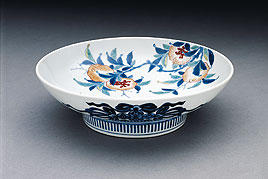
Objects for Daily Use
 |
Dish
Japan, Saga Prefecture Edo period (1600�1868), late 17th� early 18th century Porcelain painted with underglaze cobalt blue and overglaze enamels (Arita ware, Nabeshima [type] ware) H. 3 3/8 in. (8.6 cm); Diam. 11 3/8 in. (28.9 cm) Asia Society, New York: Mr. and Mrs. John D. Rockefeller 3rd Collection, 1979.250 |
The interior of this plate is decorated with a pomegranate, an auspicious motif, which symbolizes fertility because of its abundant seeds. The coins-with-ribbons on the exterior and the comb pattern on the foot are peculiar to Nabeshima ware up to the nineteenth century. During this time, most Nabeshima ware was made exclusively for the use of the Nabeshima clan lords and for presentation as gifts to other feudal lords and to the Tokugawa shogunate. The high-footed form of this dish recalls a similar form found in lacquerware. Due to similarities like this one, scholars believe that many forms of Nabeshima ware were copied from lacquer vessels.